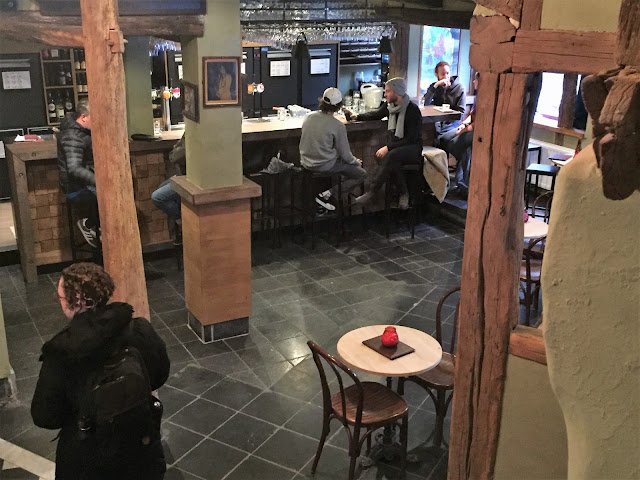At 10am on Friday 23 March 2018, Simon had not appeared so I sat in the hotel's foyer reading about Belgian breweries in my 2002 edition of CAMRA's Good Beer Guide to Belgium & Holland by Tim Webb. Simon never changes his watch from UK time so perhaps he would appear at 11am local time?
At 11.15am it was time to set off on my own and let Simon catch up later!
It is possible to visit the Stella Artois (AB InBev) brewery in Leuven but a photo of a delivery lorry in Bondgenotenlaan would suffice on this visit. Further along the road, beyond the statue of Justus Lipsius, a variety of market stalls were trading. Freshly griddled waffles (3 for 1.50 euro) were warm and very sweet.
At Monseigneur Ladeuzeplein there is a good view of the Leuven University Library and Tower.
My route to STUK was via Herbert Hooverplein and Sint-Donatus Park with remains of the original inner city walls from the 12th century.
STUK, Naamsestraat 96, 'a house for Dance, Image and Sound' includes a public cafe on the ground floor. STUKcafe is spacious with high windows on two sides and a mirror behind the bar. Although a good selection of beers was available, a coffee was my preference. By now Simon had responded to my text messages and would soon arrive after taking a direct route from the hotel.
A short walk led us to the Groot Begijnhof. This well preserved, traffic-free, beguinage dates from the early 13th century.
Simon had visited before and suggested a slow tour of the cobbled streets to appreciate the peaceful setting, now mainly occupied by university academics.
We crossed the southern part of Leuven's ring road using a pedestrian / cyclist underpass, featuring some colourful street art, just west of the river Dijle.
We had lunch and beers at De Spuye, Tervuursevest 101, overlooking the river.
The furniture had a solid, industrial, feel about it and the red theme is related to the colour of the tiles around the fireplace.
There was a short tap list here so it was an opportunity for me to drink a bottle of Orval Trappist Ale served in the correct glass.
Simon chatted with the barman and discovered that his draft blond 6% ABV Job by Biercentrum Delvaux / Brouwerij De Kroon was brewed in Neerijse, about 10 km south of Leuven, by the 'beer professor' Freddy Delvaux. A Belgium Beer Tourism blog post mentions that Freddy Delvaux and his son Filip are experts on yeast and fermentation.
It was good to see how tidy the gardens were and that we could warm up by having a look inside the temperate and tropical greenhouses which housed a pond with terrapins. Free entrance.
Continuing clockwise we headed to the Klein Begijnhof / small beguinage near Saint Gertrude's Abbey and Church, north of the city centre.
We crossed the river Dijle and headed for De Blauwe Kater, Mechelsestraat 51, which opened in its new location, facing the Vismarkt (Fishmarket), on 16 March 2018. Simon remembers visiting the bar, famous for its jazz and blues nights, in its previous location (Hallengang 1).
The interior is spacious and we took advantage of an empty table on the first floor, with a low balcony, overlooking the ground floor.
Old posters have been pasted on some areas of the wall and a blackboard gives the name of the band that will be playing on the next Monday night free gig. De Blauwe Kater has a list of over 100 beers and we resolved to return here on another day.
Before heading back to the hotel we stopped at Rector de Sommerplein to listen to some music at a 'Jamming with Fonske' gig, part of Leuven Jazz festival. The dates for the next festival have been set as 15-24 March 2019.
This area, near St Peter's and the Grote Markt, with steps and a road underpass is also the location for the statue nicknamed Fonske. An off duty tourist guide kindly explained to us that the Fons Sapientiae (Latin for 'fount of wisdom') statue was a gift from the university to the city. There was no water when we visited but it should be a fountain with water running from the glass he holds into his head representing a flow of knowledge as he reads.





















No comments:
Post a Comment